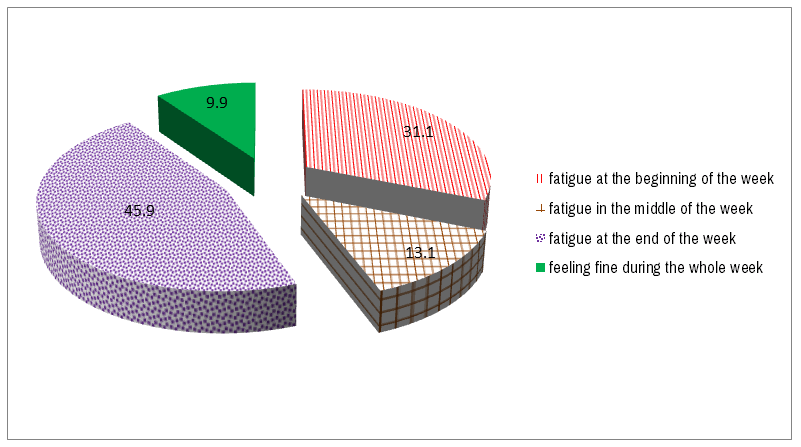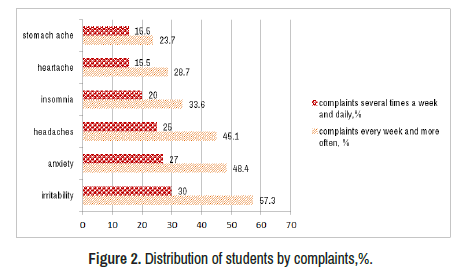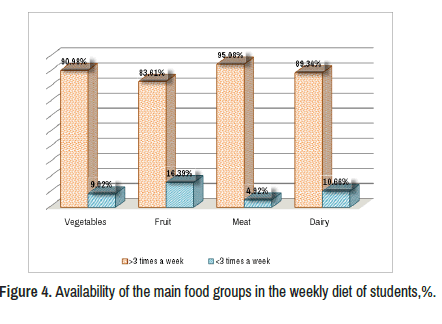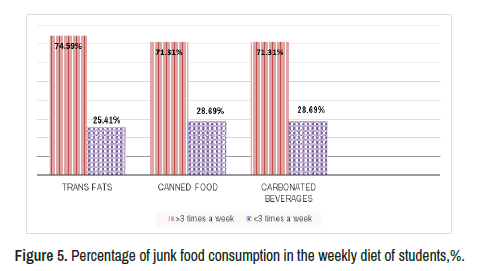Research Article - Clinical Schizophrenia & Related Psychoses ( 2021) Volume 0, Issue 0
2Department of Children's Diseases, Sechenov First Moscow State Medical University, Moscow, Russia
Anna Yu. Makarova, Department of Hygiene Children and Adolescents, Sechenov First Moscow State Medical University, Moscow, Russia, Email: mau.kaf@yandex.ru
Received: 23-Apr-2021 Accepted Date: May 07, 2021 ; Published: 14-May-2021, DOI: 10.3371/CSRP. MAKV.240521
Abstract
Objectives: The results of a subjective assessment of the quality of life of medical students are presented with the help of a questionnaire recommended by the WHO.
Methods: The questionnaire consisted of questions divided into blocks: Subjective health assessment, daily routine, lifestyle, nutrition, and physical activity. One hundred and twenty two students of the fourth year were questioned. The relationships between the indicators were described by the Pearson conjugacy coefficient.
Results: Only 12.3% of students indicated the high quality of their lives. There are negative changes in the students' lifestyles such as irrational daily routine, low motor activity, and an unbalanced diet
Conclusion: Respondents noted deviations in the state of health expressed in complaints of a vegetal nature. There are positive relation between a student's leisure and time spent on gadgets, free time and time to watch TV, free time and being overweight, satisfaction with quality of life and Body Mass Index (BMI), satisfaction with quality of life and night sleep.
https://marsbahislinki.com https://marsbetgiris.com https://mobilebahiss.com https://1xbetsgirisi.com https://onwinegiris.com https://betistegiris.com https://piacasinogiris.com https://holiganbahiss.com https://holiganbetting.com https://girisholigan.com https://mostbetegiris.com https://mariobetoyna.com https://meritgirisi.com https://meritkinge.com https://kingmerite.com https://nanogiris.com https://casinoplusa.com https://casinoplusgiris.com https://betriyal.net https://pluscasinogiris.com
Keywords
Students • Healthy lifestyle • Primary prevention • Satisfaction ladder
Introduction
According to the WHO definition, quality of life is one's perception of their position in life and in the system of values in which they live in accordance with goals, expectations, and norms [1,2]. According to the research, subjective assessments are important since they can differ significantly by region, social and demographic groups, and allow creating a complete picture of the state of society [2-4]. This research introduces the special term 'Health-related quality of life', which is widely used in the scientific literature [2].
The Economic Commission for Europe has grouped social indicators of quality of life with health ranked first [1,3]. In Western Europe and the United States, this term refers to the main organization of public health, so improving its level is the goal of all healthcare units [2-7].
Over the past three decades, negative trends in the formation of youth health have persisted in the Russian Federation. In the course of training, there is deterioration in the health of young students: There is a high prevalence of diseases of the circulatory system, nervous system, and eyes [8-18].
High mental and psycho-emotional load, forced frequent violations of work, rest and nutrition regimes require students to mobilize forces to adapt to new conditions during professional training. In this regard, it is important to study the quality of life of medical students.
Materials and Methods
The quality of life was assessed using a WHO questionnaire. The quality of life questionnaire was developed by the World Health Organization to provide a high-quality and independent instrument for assessing the quality of life of people regardless of social, cultural, demographic, and political context. The 100-question questionnaire is a multi-dimensional instrument that allows getting both an assessment of the quality of life of respondents as a whole, and private assessments for individual areas of life [1,2,6]. The questionnaire consisted of questions divided into blocks: Subjective health assessment, daily routine, lifestyle, nutrition, and physical activity. The Russian version was carefully developed and tested for validity and compliance in the WHO regional center in Russia at the Research Institute named after Bekhterev [1,5]. This method is a subjective measure of respondents' well-being and their satisfaction with their living conditions [2]. The survey included 122 medical students of the fourth year (17 boys and 105 girls). The age of the subjects was 20-22 years. The relationships between the indicators were described by the Pearson conjugacy coefficient, whose increase in degrees of freedom from 0 to 2 shows an increase in the degree of relation [19]. The research was conducted in compliance with the ethical standards set out in the Helsinki Declaration and the European community Directives (8/CO9 EC).
Question summary box
1 “Health-related quality of life” is especially important to study on students, because in the process of learning, there is deterioration in the state of health.
2 Our study revealed new correlations between the parameters of time budget, organization of the daily routine and satisfaction with the quality of life, indicating the importance of observing hygienic nutritional standards, ensuring motor activity and etc.
3 The development of comprehensive programs for primary prevention of noncontagious diseases is one of the ways to maintain and improve health.
The results of the study and the identified relations indicate the importance of observing the hygiene standards of the daily routine and organizing the student's training and leisure.
Results
Analysis of issues related to training
The vast majority of respondents (81%) noted that the duration of the academic day was 4.86 ± 1.55 hours. Analysis of questions aimed at the psycho-emotional state related with performance revealed that every third respondent felt tired from the very beginning of the week and 46% were tired by the end of the week (Figure 1).
The vast majority of respondents (84.4%) are interested in studying at the university, 5.7% feel negative about it, 9.9% of respondents are indifferent. At the same time, 16.3% of students experience learning difficulties.
Students rated their life satisfaction (quality of life) as measured by their self-definition at the top of the Cantril ladder as 6.7 ± 1.7 on average, while 12.3% of respondents rated their quality of life as 9-10 points.
Analysis of the main components of the daily routine
Analysis of the main components of the students' daily routine showed that the amount of time spent daily on rest is small and averages 3 ± 1.08 hours. Medical students sleep at night for an average of 6.07 ± 1.2 hours, which is not enough in terms of hygiene recommendations [13-16,20]. Only 23% of the respondents sleep for 7-8 hours at nights, i.e. it partially corresponds to the physiological and hygienic recommendations for the duration of night sleep (8 hours). About 45% of respondents sleep no more than 6 hours at night, and 25.4%-about 5 hours, and 6.5% sleep no more than 4 hours at night. This is due both to the need for long-term preparation of tasks for training sessions, and to the active use of various gadgets in the evening and at night. So, all the surveyed students use various gadgets on a daily basis. It takes an average of 3.2 ± 1.5 hours to prepare training tasks alone, while 45.9% spend a total of 4 to 6 hours a day communicating via computer. Thus, the preparation of homework makes a significant contribution to the time budget of a medical student.
The cost of physical activity (excluding physical education classes at the university) averaged 2.5 ± 2.2 hours per week, which does not meet the standards of physical activity recommended by the WHO [21-26]. More than half of the respondents (56.6%) had insufficient motor activity. The study of the multiplicity of motor activity in free time among students showed that 21.3% are engaged in physical activity 3-4 times a week, are not engaged at all or occasionally (1 time a month or less)–64.7%, high motor activity (more than 6 times a week) was detected only in 10.7% of respondents.
Analysis of students' complaints
Analysis of students' complaints showed that they are most of a vegetative and other nature (Figure 2). Medical students have numerous complaints of a vegetative or other nature that may indicate significant psycho-emotional stress: irritability, anxiety, headaches, and insomnia.
When evaluating the composition of the diet, it was found that students' nutrition is typical of non-regular food intake in 44.3% of cases. Apparently, the lack of time leads to the fact that during the academic day, 37.7% eat dry food every day or several times a week, and have a forced eating lifestyle. As a result, 16.4% have either a lack of body weight, and 8.20% are overweight (Figure 3).
The most frequent violation of the diet is missing breakfast. It is established that the number of students who do not have breakfast or have breakfast occasionally is 50%. The multiplicity of students' meals was on average 2.5 ± 0.59. The proportion of students who eat 3 meals a day was 55.7. In 39.3%, students have 2 meals a day, and in 4.9% 1 time a day, which absolutely does not meet the hygienic standards of nutrition.
The results of the survey show that 85.3% have an interval between meals of 5 or more hours. An unbalanced diet during the day with long intervals between meals leads to eating before bed; more than half of the surveyed students (54.1%) have a late dinner, which can contribute to excess body weight.
The study of food quality showed that the majority of students (89.8%) consider their diet to be diverse, and 10.4% indicate a lack of dairy, meat, fruits, and vegetables (Figure 4).
Excessive consumption of trans fats, canned food and sweet carbonated beverages is typical for 44% of respondents. Moreover, more than 70% of respondents consume harmful saturated fats, canned food, and carbonated beverages more than 3 times a week (Figure 5).
Discussion
Medical students rate their satisfaction with life (quality of life) as an average of 6.7 ± 1.7 out of 10 possible. The majority of medical university students (87.7%) are not satisfied with their quality of life.
The duration of the academic day in the 4th year ranged from 4.66 ± 1.15 hours minimum to 8.75 ± 1.65 hours maximum. Most of the students are interested in studying at the university; 15% of students feel negative about it. Only 10% of students feel well during the whole week, while 44% have various degrees of fatigue that adversely affect their well-being.
The study of aspects of the psycho-emotional state related to performance showed that 90% of medical students have various degrees of fatigue that negatively affect their health. The most important condition for maintaining and improving health is a healthy lifestyle, which is the basis for the primary prevention of many diseases.
The irrational mode of the day of students (lack of sleep and rest) is associated both with the need for long-term preparation of tasks for training sessions, and with the active use of various gadgets in the evening and at night. Watching TV and using gadgets increases the student's spending on this activity by 80% to an average of 5.5 hours. Thus, the preparation of homework makes a significant contribution to the time budget of a medical student.
The lifestyle of students is characterized by low motor activity in 56.6%; students are not engaged at low motor activity at all or occasionally (once a month or less) -64.7%. This fact is all the more worthy of close attention, since the respondents are medical students and are aware of the factors that contribute to the primary prevention of noncontagious diseases and maintain a healthy lifestyle.
For the normal functioning of the students' body, nutrition plays an important role. Various eating disorders are especially pronounced during studentship, because there is an incompleteness of the formation of a number of physiological systems, and the body is very sensitive to a violation of the balance of food rations.
Students' nutrition has a number of disadvantages: 44% do not have regular meals, 37% of respondents eat dry food every day or have a forced eating lifestyle, 50% of students do not have breakfast. There is a direct relationship between academic performance and diet: students who start classes being hungry experience more difficulties in acquiring educational material. Therefore, special attention should be paid not only to having breakfast before the working day, but also to its quality.
A necessary component of a full-fledged diet is a diet that involves 3-4 meals a day. The survey revealed an imbalance in the diet of students, which is manifested not only in the frequency of meals, but also in an increase in the intervals between meals. The frequency of students' meals was on average 2.5 ± 0.59: It is less than 2 times a day in 45% of students.
Apparently, the lack of time between classes also affects the increase in the intervals between meals. The vast majority of students have an interval between meals of 5 or more hours, and more than half of the respondents have a tendency to nyctophagia. Thus, an irrational unbalanced diet during the day with long intervals between meals leads to frequent eating at night combined with a lack of night sleep. It can result in the formation of a deficit or excess body weight: every fourth student has a BMI that does not correspond to the normal value.
The quality of nutrition of some students is characterized by lack of vegetables, fruits, dairy products, and consumption of saturated fat, canned and carbonated products.
Parametric correlation by the t criterion showed the presence of a positive correlation of average strength between:
• Student's free time and gadget use time (correlation coefficient 0.351), student's free time and watching TV time on weekdays (0.379) and weekends (0.452), between free time and being overweight (0.39).
• The highest score on the satisfaction ladder has a positive correlation with night sleep (correlation coefficient 0.332).
• The lowest score on the satisfaction ladder is correlated with the student's being overweight (correlation coefficient 0.36).
Conclusion
The results of a subjective assessment of the study of health parameters, lifestyle and physical activity characteristics of medical students revealed factors that affect their quality of life. The respondents use their free time to communicate via gadgets, which together with a lack of sleep, motor activity, and an irrational unbalanced diet during the day with long intervals between meals affects the development of overweight. Students who are overweight less have the lowest quality of life satisfaction score.
For medical students, a significant proportion of their time spent on studying at the university is typical (3.4-9 hours). However, the vast majority of respondents have various degrees of fatigue that adversely affect their well-being despite a fairly high motivation for learning activities.
Of course, the impact of the identified factors affects the health of students and leads to numerous complaints (irritability, anxiety, headaches, insomnia, changes in body weight), which can lead to disruption of adaptation processes, launch psychosomatic mechanisms of diseases. Ultimately, all this affects the indicators of the "quality of life" of students.
The surveyed medical students are not sufficiently aware of lifestyle factors that form health risks, which can contribute to an increase in the incidence of noncontagious diseases: Diseases of the digestive system, vision, nervous system, endocrine system and metabolism, pathology of the musculoskeletal system.
The obtained data can become the basis for further development of comprehensive programs of primary prevention of students, which is one of the ways to preserve and improve health.
Declaration of Conflicting Interests
The authors declared no potential conflicts of interest with respect to the research, authorship, and/or publication of this article.
References
- Enikeeva, Lilia Auba Kirovna and Marina Shirshikova. “Models for Predicting the Quality of Life Based on International Indices.” Modern Problems Sci Edu 1(2015): 656-663.
- Belyaeva, A Lrina. “Level and Quality of Life. Problems of Measurement and Interpretation.” Sociol Res 1 (2009): 33-42.
- Ayvazyan, S Artemi. “Russia in Cross-Country Analysis of Synthetic Categories of the Population's Quality of Life. Methodology of Analysis and an Example of its Application”. World of Russia 4 (2001): 59-96.
- Zambon, Alessio, Antony Morgan, Carine Vereecken and Sabina Colombini, et al. “The Contribution of Club Participation to Adolescent Health: Evidence from Six Countries.” J Epidemiol Public Health 64 (2010): 89-95.
- Novik, Andrey A and Ionova Tatyana. Guidelines for the Study of Quality of Life in Medicine. Moscow, Russia, (2017).
- Zlobina, G Yu. Quality of Life: Structural Components and Perspective Directions of Development. Moscow, Sotsium, (2013).
- Gaspar, Tania, Margarida Gasparde Matos, Ribeiro Dl and Leal Isabel. “Kidscreen-52: Quality of Life in Children and Adolescents”. J Child Adolesc Psychol 1(2010): 49-64
- Kobylyatskaya, IA, Osykina AS and Shkatova Elena. “The State of Health of Student Youth.” Advances Curr Nat Science 5(2015): 74-75.
- Fomenko, Oleksandr Ihorovych. “The Health of Medical Students as a Medical and Social Problem.” Astrakh Med J 1(2008): 284–286.
- Egorov, Alexey. “Self-Assessment of Student Youth Actions that Correspond to a Healthy Lifestyle” Regionologiya 4(2011):17-20.
- Namakanov, Boris and Rasulov Maksud M. “Health-Making Technologies in Teaching Students of Higher Educational Institutions.” Health-Preserving Education 2 (2011): 98–110.
- Pigasova, AA and Savochkina Diana. “The State of Health of Medical Students in the Modern Learning Environment.” Int Student Scien Bull 2(2017):19-20.
- Melikhova, EP, Libina II, Gubina OI and Natarova AA. “Features of Assessing the Health of Students When Studying at a Medical. University.” Systems Analysis and Management in Biomedical Systems 9 (2010): 19-23.
- Zuykova, AA, Petrova, TN, and Krasnorutskaya, ON “The Causal Relationship of the Lifestyle of Students of a Medical University with General Morbidity”. Electro J Bull New Med Technol 1(2013).
- Shemetova, GN, and EV Dudrova. “Health Problems of Modern Student Youth and Unresolved Issues of Organizing Medical and Preventive Care.” Saratov J Med Scientific Res 5 (2009): 526-530.
- Sukhareva, LM, Rapoport, IK, and Polenova, MA “The State of Health of Moscow School Children and Factors Affecting its Formation (Longitudinal Study)” ZNISO 3(2014): 28-30.
- Baranov, Annaa, Rapoport IK, Sukhareva LM, and Namazova-Baranova et al. “The State of Health of Modern Adolescents.” Pediatr (2014): 15-41.
- Baranov, Anna, Sukhareva, LM and Rapoport, IK “The Importance of Adolescent Health in the Formation of their Harmonious Development” Hygiene and Sanitation 6(2015): 58-61.
- Lapach, Sehri, Chubenko Artem V and Babich, Pavel Nikolaevich. Statistical Methods in Biomedical Research Using Excel. Kiev, Morion, (2000)
- Zhuravleva, Irina V (Ed.) Students' Health: A Sociological Analysis 1,4. Moscow, Institut Sotsiologi RAN, (2012).
- Baranov, Anna, and Sukhareva, L.M. Medical and Social Aspects of the Adaptation of Modern Adolescents to the Conditions of Upbringing, Training and Work: A Guide for Doctors Moscow, GEOTAR-Media, (2007).
- WHO (World Health Organization). The Young and Physically Active: Increasing the Attractiveness of Physical Activity for Children and Young People WHO: European Regional Bureau 44 (2013).
- Kashaeva, Olga, Krizhanauskayte Galina Albertovna, and Shepelkov Andrey Alekseevich . “Studying the Quality of Nutrition of Student Youth.” NovaInfo 24(2014).
- Blinova, EG, and Ogleznev, GA Fundamentals of Rational Nutrition and Hygienic Assessment of the Nutritional Status of Students: Monograph Omsk, OmGMA Publ, (2007).
- El Ansari, Walid, Sakari Suominen, and Gabriele Berg-Beckhoff. “Is Healthier Nutrition Behaviour Associated with Better Self-Reported Health and Less Health Complaints? Evidence from Turku, Finland.” Nutrients 7(2015): 8478-8490.
- Gaspar, Tania, José Pais Ribeiro, Margarida Gaspar de Matos, Isabel Leal, et al. “Health-Related Quality of Life in Children and Adolescents: Subjective Well Being.” Span J Psychol 15 (2012): 177-186.
Citation: Makarova, Anna Yu, Vladislav R. Kuchma, Elena V.Naryshkina and NataliaL.Yamshchikova."Quality of Life of Medical Students.” Clin Schizophr Relat Psychoses 15S(2021). Doi: 10.3371/CSRP. MAKV.240521.
Copyright: © 2021 Makarova AY, et al. This is an open-access article distributed under the terms of the Creative Commons Attribution License, which permits unrestricted use, distribution, and reproduction in any medium, provided the original author and source are credited. This is an open access article distributed under the terms of the Creative Commons Attribution License, which permits unrestricted use, distribution, and reproduction in any medium, provided the original work is properly cited.











